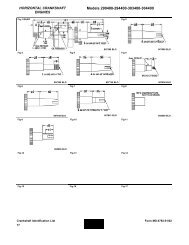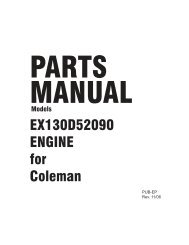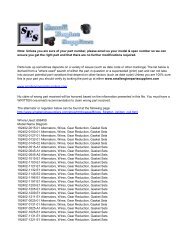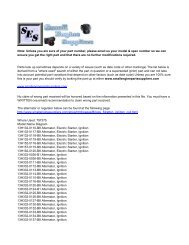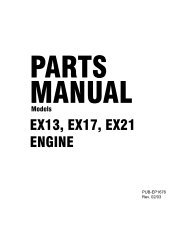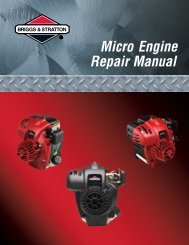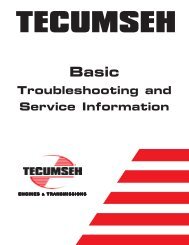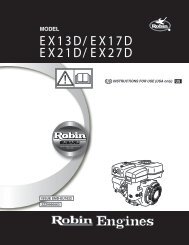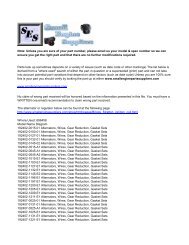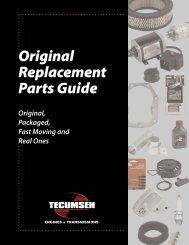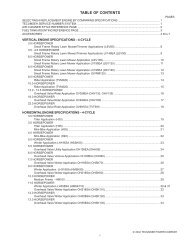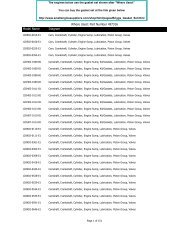TC/TM SERIES 2-Cycle Engines - Small Engine Suppliers
TC/TM SERIES 2-Cycle Engines - Small Engine Suppliers
TC/TM SERIES 2-Cycle Engines - Small Engine Suppliers
- No tags were found...
You also want an ePaper? Increase the reach of your titles
YUMPU automatically turns print PDFs into web optimized ePapers that Google loves.
TESTING1. After repeated efforts to start the engine using the procedure listed in the operator's manual fail, check for spark byremoving the high tension lead and removing the spark plug. Install a Tecumseh Spark Plug Tester (part # 670366)and check for spark. If the spark is bright blue and fires every revolution, proceed to step # 2. If no spark, weak spark,or intermittent spark, see Chapter 6 "Ignition" under "Troubleshooting".2. Remove the spark plug and visually check the removed spark plug for a wet condition indicating the presence offuel mixture in the cylinder.3. If the spark plug is dry, check for restrictions in the fuel system before the carburetor. If the spark plug is wet,continue with step #7. Check the fuel cap vent, the cap must allow air to be blown through it when testing. Using aproper draining receptacle, remove the fuel line from the carburetor inlet fitting (<strong>TC</strong> Type I) or fuel tank (<strong>TC</strong> Type II/<strong>TM</strong>) and pull off the fuel line. Examine the fuel flow and fuel condition. Improper fuel flow indicates the fuel, fuel line,filter, or tank require cleaning or replacement.4. Visually inspect the choke shutter for complete closing or check to see fuel flowing from the main nozzle duringpriming. Remove the air cleaner element or air cleaner assembly to provide access for visual inspection.5. If the fuel flow to the carburetor is adequate and no fuel flows out the main nozzle during priming or choking, thecarburetor will require service. Consult the Troubleshooting Carburetion Chart for possible causes for the lack offuel.6. Check the compression release on <strong>TM</strong> engines. Low compression, no fuel present on the spark plug, adequate fuelflow and a known good functional carburetor indicates an internal engine problem exists. See Chapter 7 under"Troubleshooting".7. Check the engine compression using compression tester (part # 670358) and follow the tester's recommendedprocedure. Low compression, no fuel present on the spark plug, adequate fuel flow and a known good functionalcarburetor indicates an internal engine problem exists. See Chapter 7 under "Troubleshooting".SERVICECARBURETOR PRE-SET AND ADJUS<strong>TM</strong>ENTThe Walbro, Tillotson and Tecumseh carburetors used on<strong>TC</strong> engines have non-adjustable main mixture jets. Onlythe idle mixture may be adjustable by turning the idlemixture screw. Use the following procedure to pre-set theidle mixture screw. Turn the idle mixture screw(clockwise) finger tight to the closed position, then turn thescrew counterclockwise to obtain the proper preset (diag.3-10).Walbro model WTA, WTTillotson model HUTecumseh model1 - 1 1/8 turns1 1/4 - 1 3/8 turnsFixedFinal Idle Mixture AdjustmentStart the engine and allow it to reach normal operatingtemperature (after 3-5 minutes). As the speed control isset at the idle position, turn the idle mixture screw slowlyclockwise until the engine R.P.M. just starts to decrease.Stop and note this screw position. Turn the idle mixturescrew slowly counterclockwise. The engine will increaseR.P.M. Continue to slowly turn the screw until the engineR.P.M. starts to decrease. Note this position and turn themixture screw back clockwise halfway between the twoengine R.P.M. drop off positions. The idle mixtureadjustment is complete.Idle Mixture Screw3-1019



